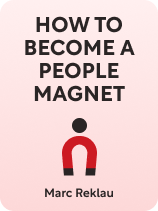

This article is an excerpt from the Shortform book guide to "How to Become a People Magnet" by Marc Reklau. Shortform has the world's best summaries and analyses of books you should be reading.
Like this article? Sign up for a free trial here.
Do you know how to influence others effectively? How effective are you at drawing them in and winning them over to your ways of thinking?
Mastering the art of persuasion is a valuable skill in all facets of life. In How to Become a People Magnet, Marc Reklau explores three methods of persuasion: leading people to your ideas, appealing to authority, and focusing on positive responses.
Keep reading to discover how you can apply these methods in your daily life and increase your ability to influence others.
Persuasion Methods
The last social skill Reklau discusses is the art of persuasion. Because people are self-interested, persuasion means making them want what you want. Reklau offers three methods of persuasion: leading people to your idea, appealing to authority, and focusing on yeses. Let’s look at each of the strategies in more detail.
(Shortform note: Before you start trying to persuade someone, rhetoric professor Jay Heinrichs (Thank You for Arguing) suggests you take time to consider what your goal is. Determining your goal will help guide you toward using certain methods. If you’re trying to persuade someone to feel a certain way, for example, you’ll want to use emotional appeals. In addition, clarifying your goal will help you focus on convincing the other person to see things your way instead of on trying to beat them—as the latter is more likely to lead to unproductive conflict.)
Method #1: Lead People to Your Idea
Reklau suggests that people don’t like feeling forced or pressured into doing something. So instead of using direct demands, try to lead someone to come up with your idea through questioning or brainstorming. When they feel like they came up with it, they’ll be more likely to want it. For example, Anne wants to go to Atlantic City with her friends for the weekend. But instead of demanding they go, she offers the suggestion early to get the idea in their heads. Then when she asks them where they want to go later on, they’re more likely to suggest it as their own idea.
(Shortform note: Debater Peter Andrei (How Highly Effective People Speak) explains that you can employ cognitive biases to lead people to certain ideas—in other words, you can take advantage of how the brain processes information to get people to focus on what you want. For example, he explains that people are biased toward choices that carry no risk, even if they also give less of a benefit. Therefore, you can help lead someone toward your idea by mentioning ahead of time that it carries no risk of failing or causing any kind of loss.)
Method #2: Appeal to Authority
Reklau explains that you can quote or reference important people to convince the other person you’re right. This connects your idea to that person’s authority and makes it seem like the idea isn’t coming directly from you—making people feel less like you’re forcing your idea on them. For example, in our previous scenario Anne might point out the many positive online reviews of places in Atlantic City during her vacation negotiations. This allows her to appeal to a third party with more weight—the large number of people who wrote positive reviews.
(Shortform note: Robert Cialdini (Influence) elaborates on why appealing to authority is so persuasive. According to him, society teaches us to respect and obey centralized authority. This is the main thing that separates civilization from anarchy, so it holds a great deal of cultural importance. Cialdini explains that this urge is strong enough that people even respect symbols of authority like uniforms or badges of important people. Therefore, when you mention a source of authority, people are socially trained to believe and trust it.)
Method #3: Focus on Yeses
Reklau says that if you focus on “yeses,” people will tend to be more agreeable to your idea. To do this, ask someone multiple questions you know they’ll say yes to before you pitch your idea, so they’re more used to saying yes to you. For example, Anne might start pitching activities she knows her friends like so they start saying “yes” before she mentions Atlantic City.
You can also try offering “this or that” choices so they can’t say no and have to focus on yeses. For example, instead of asking if her friends want to go to Atlantic City or not, Anne might offer them choices between various places they could go in Atlantic City.
(Shortform note: Persuasion expert Robert Cialdini (Pre-Suasion) further elaborates on why focusing on yeses is so effective. According to him, people assume the information preceding their decision is relevant—in other words, whatever they were thinking about before your pitch will influence their response, regardless of whether it’s actually relevant. So when you get someone focused on things they want to say yes to, they’ll connect that positive feeling to whatever you’re persuading them on.)

———End of Preview———
Like what you just read? Read the rest of the world's best book summary and analysis of Marc Reklau's "How to Become a People Magnet" at Shortform.
Here's what you'll find in our full How to Become a People Magnet summary:
- Why charisma is a learned skill, not something you’re born with
- How to make a first impression that’s unforgettable
- How to persuade people to do what you want






